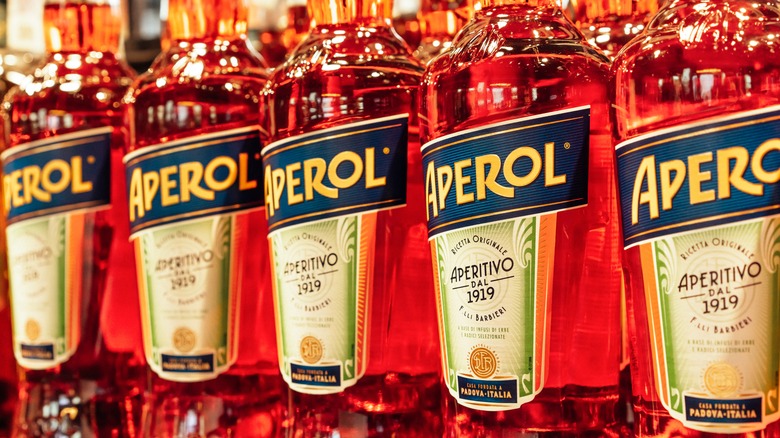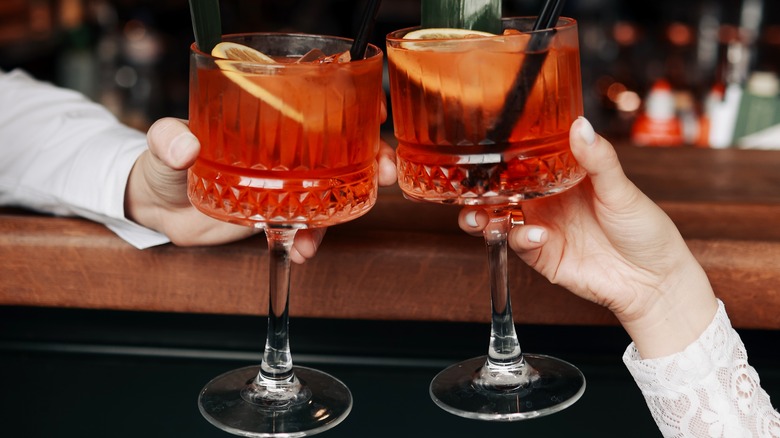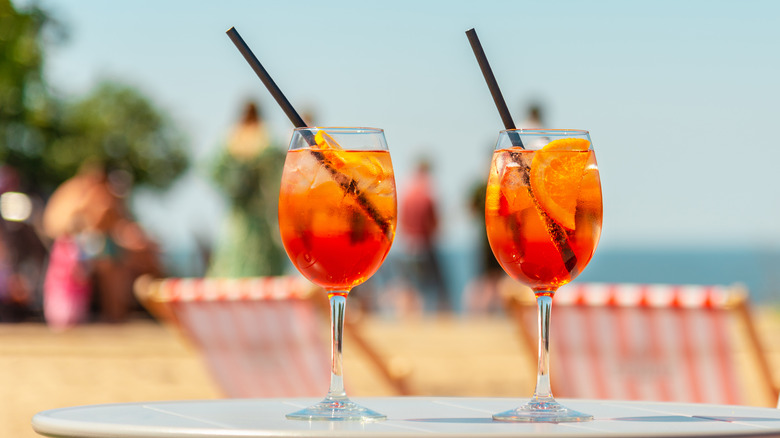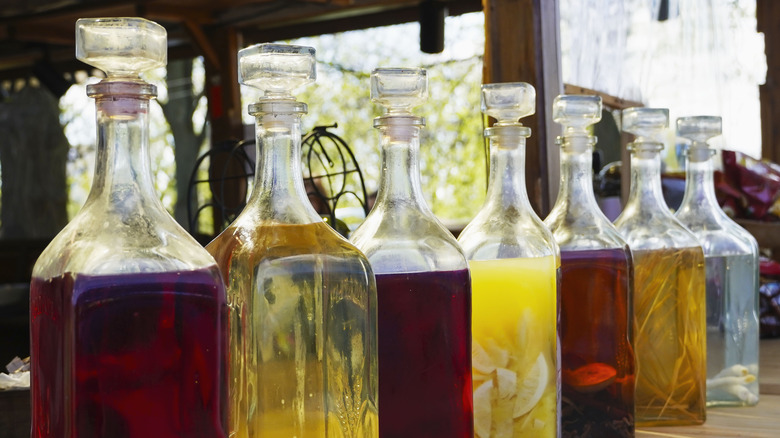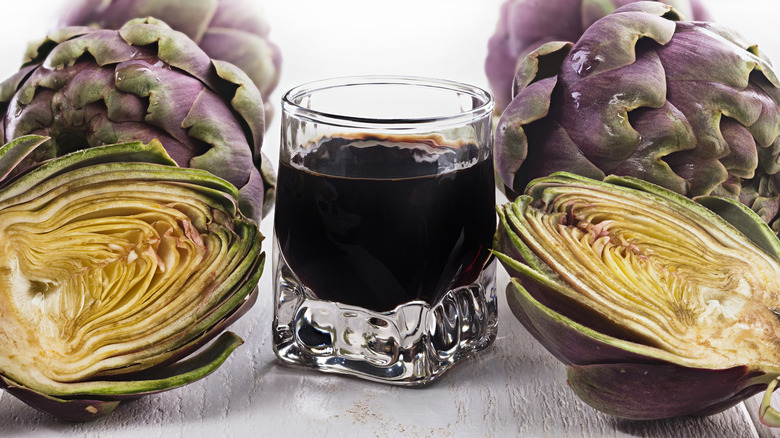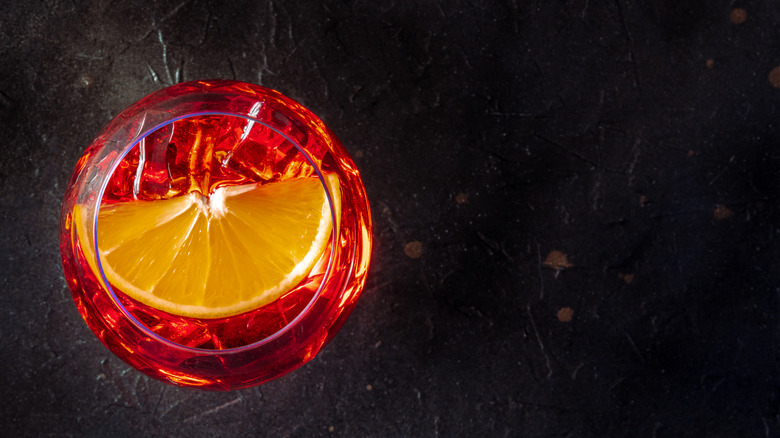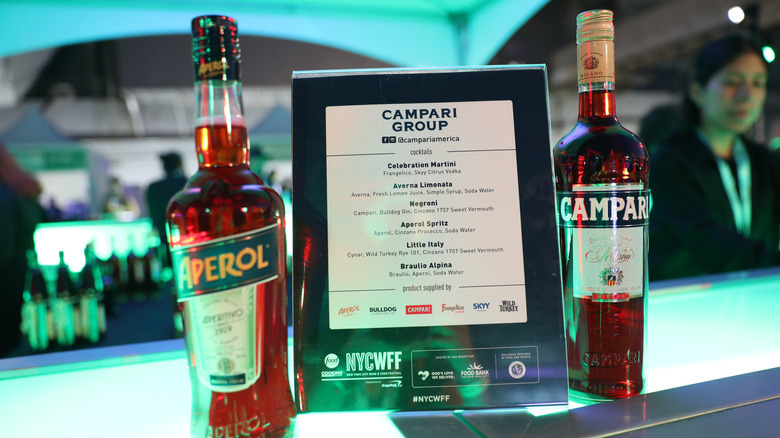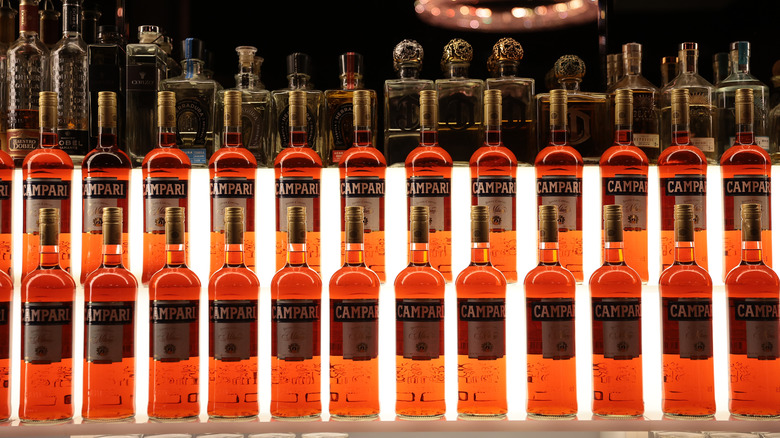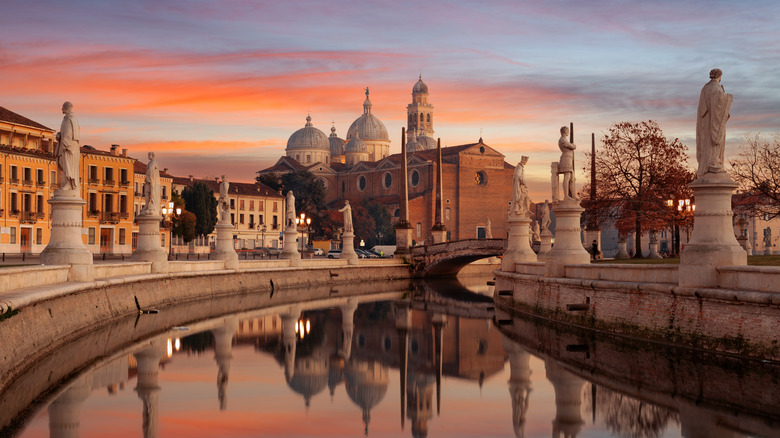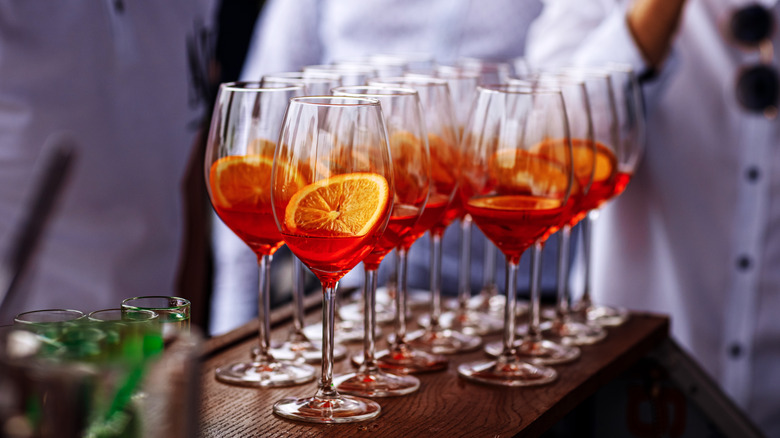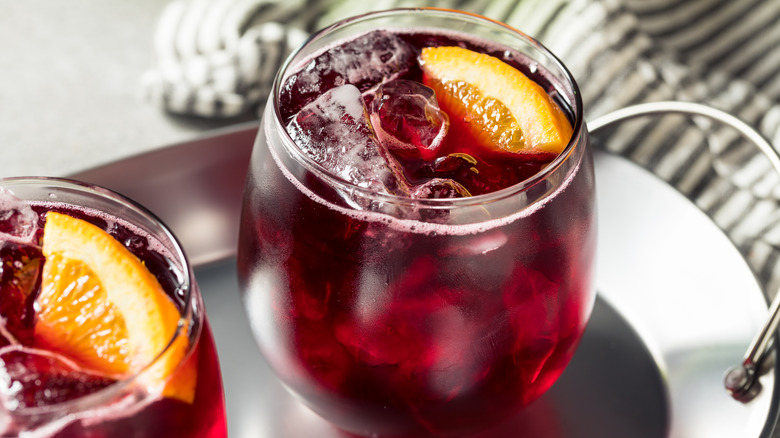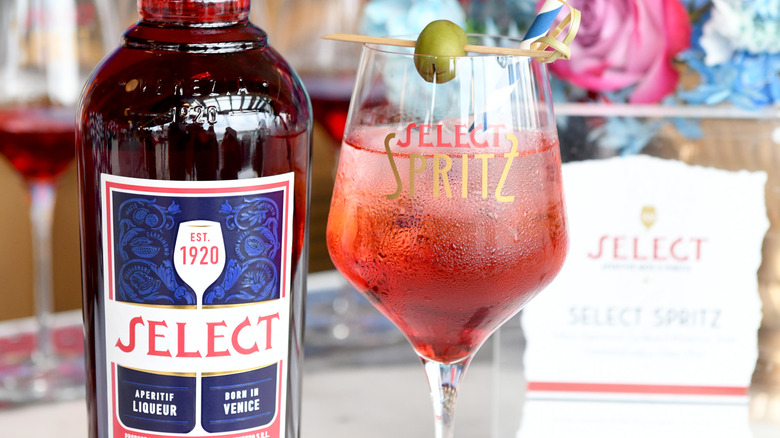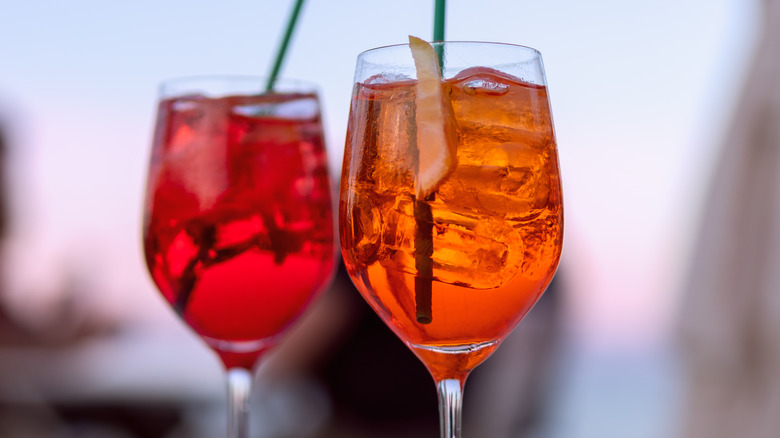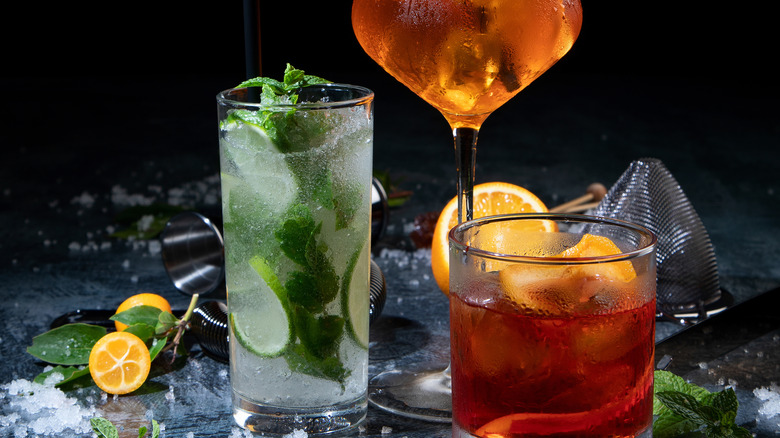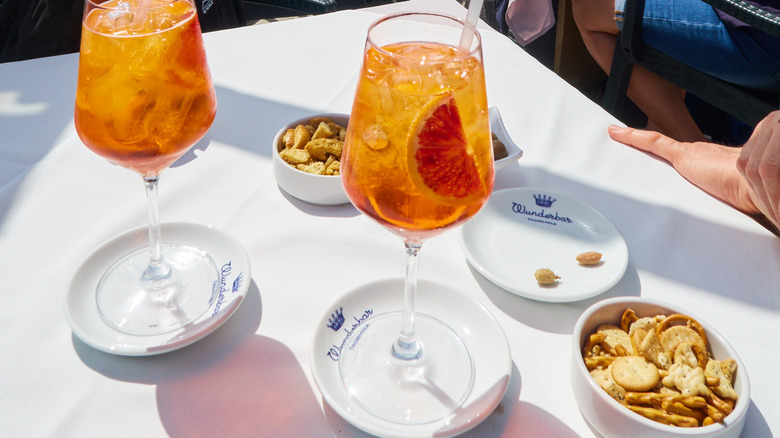14 Facts You Need To Know About Aperol
As summertime approaches, with it comes summer drinks, including effervescent cocktails like the Aperol spritz. With its appealing sunset-orange color, a blend of sweet, aromatic, and bitter flavors, and a simple recipe, the Aperol spritz is light and refreshing, the perfect beverage for a gathering in the early evening. Just combine three ingredients in the easy-to-remember ratio of 3-2-1 (three parts Prosecco, two parts Aperol, one part sparkling water), garnish with an orange slice, and you've got a delightful fizzy cocktail drawn from Italy's vibrant aperitivo tradition.
It's hard to think of Aperol without thinking of the signature cocktail made with it, but the story of Aperol itself didn't begin with the spritz. Aperol originates from a rich culture of alcoholic drinks as accompaniments and enhancements to food, part of the regular rhythm of a traditional Italian dinner: aperitivo before, wine during, digestivo after. But what ingredients flavor this enticing orange beverage? And are there any other ways you can use Aperol besides in a spritz? Here's a comprehensive guide to this eye-catching Italian liqueur.
Aperol is on the rise
Consumers are increasingly drawn towards lighter drinks with all-natural ingredients and a lower alcohol content, meaning that Aperol fits right in with current trends in the alcoholic beverage market. Recent popular T.V. shows that feature the Aperol spritz and Italian aperitivo culture, like HBO's "The White Lotus", have also played a role in raising Aperol's global profile. But Aperol's current popularity is largely due to 20 years of effective marketing by parent company the Campari Group, which acquired Aperol in 2003 when it was still little-known, and has since grown it into one of its most profitable international labels.
Beginning in 2004, Aperol's sales grew by an average of 16.5% each year, according to Reuters, until growth plateaued in 2020 due to the coronavirus pandemic. Double-digit growth has returned as of 2021, and Aperol is still growing even as sales of other Campari Group brands decline.
The Italian aperitivo custom is the origin of Aperol
Aperol is an example of an aperitivo, the Italian equivalent of a French aperitif: An alcoholic beverage meant to be consumed before a meal to stimulate the appetite. A similar drink meant to aid digestion after the meal is called a digestivo (French digestif). The history of the word aperitivo derives from a Latin word for opening: in this case, it's the stomach or the appetite that is being opened ahead of dinner. The ancient Romans drank wine infused with herbs and spices before and after meals, and also used similar concoctions medicinally. These boozy herbal medicines were refined by European monks during the Medieval era, giving rise to modern liqueurs like Aperol.
In Italy, aperitivo also refers to the cultural ritual around consuming this type of beverage. Similar to a happy hour, the aperitivo occurs in the early evening before dinner, which is customarily served later in Italy than in the U.S. and some other countries. Light pre-dinner snacks such as olives, nuts, or crunchy biscuits traditionally accompany aperitivo drinks, though some modern bars have expanded this into a full buffet called "apericena," a portmanteau of aperitivo and cena (dinner).
Aperol is a liqueur, not a liquor
There are numerous types of liqueurs and they can vary widely, from sweet, aromatic Grand Marnier to earthy, complex Chartreuse. But, in general, a liqueur is defined as a mixture of distilled alcohol, sugar, and flavorings derived from plants, such as extracts or fruit juices. A resting period may be required in the production of some liqueurs to allow the flavors to combine, but liqueurs are not aged for long periods; rather, they start with aged spirits as a base to which other ingredients are added.
While hard liquor typically contains 40% to 50% alcohol, most liqueurs are in the range of 15% to 30%. Aperol contains only 11% alcohol, low for a liqueur and about the same as the average wine. Broadly speaking, liqueurs are not intended to be drunk in large quantities on their own. Many can be mixed into cocktails, sometimes with no other ingredient than soda water, but it's traditional in Italy to slowly sip a small amount of bitter liqueur by itself as an aperitivo or digestivo.
To be more specific, Aperol is an amaro
Amaro is Italian for bitter, a flavor that is widely appreciated in Italian cuisine; think of bitter vegetables like endive and broccoli rabe, or the pungent flavors of espresso, dark chocolate, and candied citrus peel. The word amaro (plural amari) also refers to a family of bitter-tasting Italian liqueurs infused with herbs, originally served as medicinal tonics to aid digestion. Aperol is just one type of amaro, but other well-known examples include Campari, Fernet-Branca, Cinzano, and Cynar. Found all over Italy, many amari were originally prepared on a small scale for personal use by monasteries or families according to their own recipes, and some of today's major international brands of amari started out this way.
Aperol is sweeter and less bitter than many amari, which makes it more widely accessible to those who have not acquired a taste for this type of beverage. Amari tends to have powerful, complex flavors that come from its many ingredients. In some brands, dozens of different kinds of flowers, leaves, roots, and bark are infused into the alcohol, including unlikely choices such as artichokes, a major flavoring in Cynar, or rhubarb, which is used in making Aperol.
The flavor of Aperol comes from a blend of ingredients
The exact recipe for Aperol is a proprietary secret, but some of its natural flavorings are widely known. In addition to rhubarb, Aperol contains orange oil derived from both sweet and bitter oranges, although the drink's orange color is artificial. Aperol is also made with gentian and quinine, two ingredients that hint at the ancient connection between liqueur and medicine. Both are commonly used in other bitter drinks, including other types of amari, and both have a history of being used medicinally.
Gentian root, found in Angostura bitters and in many French and Italian liqueurs, was used historically to treat stomach problems and various other ailments, though its medicinal value is unproven. Quinine, derived from the bark of the South American cinchona plant, is the primary flavoring in tonic water and was once the only known treatment for malaria. Aperol's official website doesn't reveal any of the other flavoring ingredients, but it's guaranteed vegan and free of nuts and major allergens.
Campari and Aperol are made by the same company
Since Gaspare Campari invented his famous red amaro liqueur in northern Italy around 1860, the company he founded has grown into the multinational Campari Group, one of the world's largest spirits producers. In addition to Campari and Aperol, the Campari Group owns many well-known alcohol brands, including Wild Turkey whiskey, SKYY vodka, and Espolón tequila. When the Campari Group purchased Aperol in 2003, the brand was little-known outside of northern Italy and earned less than $59 million USD per year. Today, sales of Aperol alone account for about a fifth of the Campari Group's $2-billion annual revenue, per Reuters.
The Campari Group's initial efforts to market Aperol focused on the spritz. More recent marketing has introduced new ways to enjoy Aperol, such as by pairing it with a meal instead of light aperitivo snacks. Imitators like Moet-Hennesey's ready-made Chandon Garden Spritz have attempted to capitalize on Aperol's success, but the Campari Group's CEO has expressed that he's not worried about them eclipsing the original.
Despite their similarities, Aperol and Campari are very different
The two most-famous and most-popular amari are both brilliantly colored and contain bitter gentian root, both can be enjoyed with soda water, and both are now owned by the same company. However, for all their similarities, there is more than one difference between Aperol and Campari.
First, there's the color: Aperol is orange, and Campari is redder. Both are colored artificially (in most markets, Campari is no longer colored with carmine dye derived from cochineal insects, as it once was). Then there's the flavor: Aperol is sweeter and less bitter than Campari. At up to 28.5%, Campari's alcohol content is high for a liqueur and more than double that of Aperol. Campari was invented in Piedmont, a region in the northwest of Italy, around 1860, making it decades older than Aperol, which was invented in the Veneto region in Italy's northeast in the early 20th century.
Padua was the birthplace of Aperol
The modern form of aperitivo culture emerged in the 19th century, in the northern Italian city of Turin. There, bars and street vendors began selling small glasses of medicinal amari in the early evening with light snacks, in keeping with the general Italian custom of serving alcohol alongside food and echoing an earlier local tradition of eating a Sunday lunch of assorted small dishes with wine. From Turin, the aperitivo as a public social ritual spread in popularity to other cities, including Padua in the Veneto region.
As aperitivi grew in popularity at the beginning of the 20th century, brothers Luigi and Silvio Barbieri of Padua set out to develop a sweeter, milder type of amaro than what was currently on the market: an aperitivo drink that would be unique to their home city. They came up with the name Aperol from the word "aperitivo" itself.
Aperol is more than 100 years old
The Barbieri brothers debuted Aperol at a food and drink expo held during the 1919 Padua International Fair, where it was an instant success. Over the next few decades, Aperol would spread from Padua to other cities in Veneto, though it was not yet widely known in the rest of Italy or internationally. The Campari Group maintains that the brothers' original secret recipe has remained unchanged to this day.
Aperol was always intended as an aperitivo, but it was originally sipped neat, as many amari still are in Italy today. Later it would be added to the spritz: first with soda water and still wine, and then with Prosecco, which is also a unique product of Veneto and the smaller neighboring region of Friuli-Venezia Giulia. In parts of Italy today, you can still encounter the original version of the spritz made with still wine, known as Veneziano (Venetian-style).
The spritz was not originally made with Aperol
The name of the spritz hints at its non-Italian origins: When pronounced "shpritz," it's the German word for splash. In the early 1800s, before the unification of modern Italy, Veneto fell under the control of the Austro-Hungarian Empire, which brought an influx of Austrian soldiers into northeastern Italy. Accustomed to beer, these soldiers found Italian wine too strong for their taste, so they began diluting it with a splash of soda water. White wine and soda water remains a popular beverage, known under various names, including spritzer.
In the 1920s, the spritz Bianco was adapted to the Italian palate with the addition of bitter amaro, and this was the version of the cocktail that would spread throughout northern Italy and later, the world. However, Aperol was not the first amaro used to make a spritz: That was Select, another reddish amaro from Veneto that is still marketed as "the original Venetian spritz."
The Aperol spritz wasn't popularized until the 1950s
The Select aperitivo is another amaro that appears similar to Aperol in its appearance, sweetness, and low alcohol content, but Select has a richer reddish-brown color and a more complex flavor with notes of vanilla. It was invented in Veneto's capital city of Venice and hit the market in 1920, just a year after the Barbieri brothers invented Aperol. Select is still the preferred liqueur for a spritz in Venice, and was the first amaro added to the cocktail, but the Aperol version would follow soon after.
By the mid-20th century, Veneto was known for both styles of spritz: the "continental style," made with Aperol from Padua, and the "lagoon style," made with Select from the "lagoon city" of Venice. The final component in the modern spritz recipe, sparkling Prosecco, was first added to the cocktail instead of still wine around the 1970s, though it continues to be made with still wine in Venice.
There are variations on the Aperol spritz
As we've seen, the very first spritz was made with Select. Some of the main alternatives for an Aperol spritz are spritzes made with other amari like Campari and Cynar, sometimes with additional ingredients to complement their differing flavors. A spritz may be served in a wineglass or rocks glass, though some bartenders prefer a Collins glass to help the bubbles in the drink remain concentrated. It's recommended to add ice and Prosecco to the glass first, then Aperol, and finally soda water, to prevent the Aperol from settling at the bottom of the glass, and the Aperol should be chilled for the best results. While the traditional garnish for an Aperol spritz is an orange slice, it may also be garnished with an orange or lemon peel, or with an olive. You can also enhance the sweetness of an Aperol spritz by balancing it with a briny splash of olive juice.
When making a spritz, be sure to use a dry Prosecco so your cocktail won't end up overly sweet. Mixing Aperol with just Prosecco creates a headier beverage, similar to the spritz but not quite as light. For a unique take on the Aperol spritz, you can also try pairing the orange liqueur with other fizzy, sweet beverages with earthy, aromatic notes that complement its subtle bitterness, such as grapefruit soda, ginger beer, vanilla Coke, or even a light beer.
Many other cocktails can be made with Aperol
Next time you're in the mood for some Aperol, think beyond the spritz. Aperol is more versatile than you might think, and bartenders have come up with a variety of ways to pair it with ingredients that enhance its sweet and bitter flavors. And just as Campari is used in making the Negroni and other drinks, there are many other cocktails to make with Aperol.
As in a spritz, you can always experiment with mixtures of Aperol and wine, varying the flavors with other ingredients, such as in an Aperol sangria. A dash of Aperol can brighten up classic mixed drinks like a Cosmopolitan or Margarita with its delicate citrusy bitterness. It can also be used in place of Campari in a Negroni, producing a sweeter and less intensely bitter Aperol cocktail that might go down easier than the original. You can even try Aperol in an ice cream float with other fruity flavors like raspberry.
It pairs well with food
The concept of pairing Aperol with food is nothing new. After all, in Italy, alcoholic beverages and food are regarded as inseparable. The aperitivo itself is a prelude to dinner, but an aperitivi like the spritz is always accompanied by at least some kind of light snack to nibble on. In Aperol's native Veneto, these assorted small dishes are called cicheti or cichetti, typically eaten with the hands while standing at the bar in establishments called bacari. Similar to Spanish tapas, cichetti may include small pieces of toasted bread with a topping, olives, boiled eggs, fried cheeses, and vegetables, or bite-sized seafood like shrimp and baby octopus.
Aperol's own website recommends pairing the beverage with crispy herbed crackers, crostini, arancini, and other Italian appetizers, or with a charcuterie board. Moving further from tradition, you may wish to pair your Aperol spritz with a full meal, and at some American restaurants, the spritz has emerged alongside mimosas and Bloody Marys as a brunch cocktail. With so many possible ways to enjoy it, Aperol is here to stay.
Static Media owns and operates Tasting Table and Mashed.
